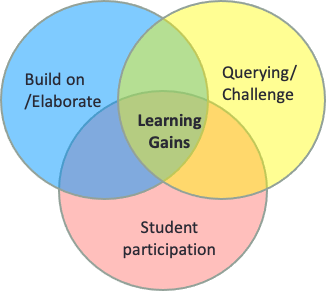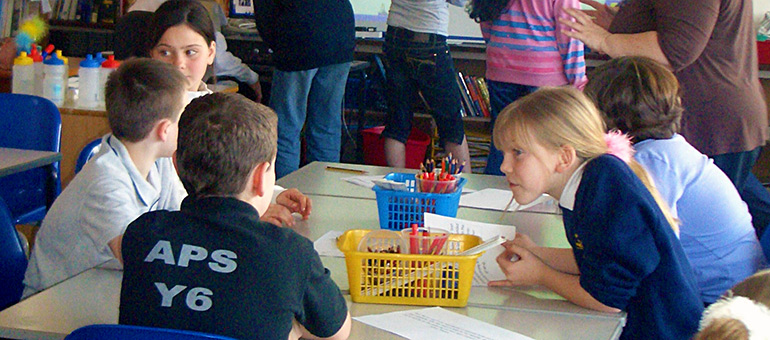Does it really make a difference for student learning?
Project Introduction
Ever since Plato’s analysis of Socratic dialogue, the forms of talk that occur in classrooms have been spotlighted as critical for teaching and learning. How should teachers talk to their class, and how much should they do this? How much should children participate in classroom interaction, and what form should their participation take? How much should children respond to teachers or discuss ideas amongst themselves?
Over the years, theories have been proposed that seek to answer these questions, yet hard evidence remains elusive. Our project has attempted to provide this evidence. Our analyses assess whether there is a positive relationship between patterns of classroom dialogue and student learning, reasoning and attitudes to school. Moreover if there is, we ask whether its magnitude is sufficient to carry significant implications for policy and professional development.
Project Methods
Successive lessons have been video-recorded in 72 Year 6 classrooms (students aged 10 to 11 years), with literacy, mathematics and science all covered. Situated in London, the Home Counties, East Anglia, the Midlands and Yorkshire and including urban and rural locations, the classrooms are socio-economically and ethnically diverse (0-100% of pupils eligible for free school meals, mean=19.3%; 0-96% from minority ethnic backgrounds, mean=32.6%).
Recordings focus upon dialogue where teachers are involved (with whole classes, small groups and individual students), but group work that is limited to students is also sampled.
Lesson recordings have been coded using the Cambridge Dialogue Analysis Scheme (CDAS). This was adapted from the Cam-UNAM Scheme for Educational Dialogue Analysis (SEDA), developed as part of the Faculty’s collaboration with Mexican colleagues.
Our scheme, which has been subject to reliability and validity checks, involves coding each speaker turn to represent the detail, and rating whole lessons to represent the broader picture. The 12 coding categories and 5 rating scales reflect theories of what constitutes good dialogic practice, jointly allowing recordings to be graded for approximation to such practice. Considerable variation has been detected across classrooms over many key features of dialogue.
To assess the implications, dialogic practices have been related to student outcome measures, with around 1700 students providing data. The measures address:
- curriculum mastery in English and mathematics (scores on 3 statutory Standardized Achievement Tests - SATs) and in science (scores on a specially designed test of conceptual and procedural knowledge);
- verbal reasoning (scores on a specially designed test that taps the ability, e.g., to differentiate facts from opinions and reasons from conclusions, to draw inferences, and to compare and evaluate reasons);
- attitudes to schooling and self-as-learner (scores on the standardized Pupil Attitudes to Self and School scale - PASS).
To interpret dialogue-outcome relations, we needed to conduct our analyses controlling for other factors that are related to dialogue and outcome. We identified over 30 possible factors, and we assessed them all using questionnaire and observational data. In the end, our results indicated that only three factors needed to be controlled: student prior attainment, student initial attitudes and engagement, and (with the focus on teacher-student dialogue) group work amongst students. It is of interest that:
- student socio-economic status and mastery of English were unrelated to patterns of classroom dialogue;
- group work was generally of high quality (see details in our BERA blog post), but nevertheless quality varied – and variation mattered: the higher the quality of group work, the stronger the performance on two SATs and our reasoning test.
Major Findings
Three aspects of teacher-student dialogue strongly predicted performance on SATs when they occurred in combination (but not alone):
- Elaboration - where building on/elaborating/evaluating/clarifying of a previous contribution was invited or provided), e.g. (from two students discussing a poem) ‘It kind of makes them sound alive’, ‘It has really good rhythm’;
- Querying - where a previous contribution was doubted/challenged/rejected, e.g. ‘I think similar to Eunice, but not…I’ve kinda got two theories’;
- Student Participation (where across the lesson multiple students were seen to engage with each other’s ideas, and not merely respond to their teacher’s questions).
In particular, when Student Participation was high, high levels of Elaboration and Querying were positively associated with SATs scores, even with start-of-year attainment taken into account. When Participation was low, there were no positive effects of high frequency Elaboration and Querying. When Elaboration and Querying were of low frequency, there was no positive effect of Participation.

Elaboration was also positively associated with PASS scores: high levels of Elaboration meant relatively positive attitudes to schooling and self-as-learner, even with start-of-year attitudes taken into account. As yet, we have not detected any relations between teacher-student dialogue and scores on our science test. And while we did not find strong effects of teacher-student dialogue on students’ scores on our reasoning test, we did find that group work - if, and only if, it was of a high quality - was linked to high reasoning scores. At the same time, what we call ‘Reasoned dialogue’ (inviting or providing an explanation or justification for own or other’s contribution) has not turned out to be related to any outcome measures. Yet this aspect of dialogue has been emphasized in much contemporary literature.
Overall, our project makes a unique contribution to the field through offering a systematic, large-scale analysis of the relationship of classroom dialogue across core subjects with student learning and attitudinal outcomes and through informing researchers and practitioners about which dialogic moves are the strongest predictors of learning. Information for practitioners began with a series of professional development workshops for the participating teachers, when the results were discussed and disseminated in a concrete way as regards classroom practice.
Research team
- Principal Investigator
Professor Christine Howe - Co-investigators
Dr Sara Hennessy
Professor Neil Mercer - Research Associates
Dr Maria Vrikki
Dr Lisa Wheatley
Funding
ESRC Research Grant no. ES/M007103/1
Publications
Amodia-Bidakowska, A., Hennessy, S. & Warwick, P. (2023). Disciplinary dialogues: Exploring the association between classroom dialogue and learning outcomes within and between subjects in English primary schools. Learning, Culture and Social Interaction 43. https://doi.org/10.1016/j.lcsi.2023.100742
Hennessy, S., Calcagni, E., Leung, A., & Mercer, N. M. (2021). An analysis of the forms of teacher-student dialogue that are most productive for learning. Language & Education. https://doi.org/10.1080/09500782.2021.1956943 (open access)
Hennessy, S., Howe, C., Mercer, N., and Vrikki, M. (2020). Coding classroom dialogue: Methodological considerations for researchers. Learning, Culture and Social Interaction, 25. https://doi.org/10.1016/j.lcsi.2020.100404.
Howe, C., Hennessy, S., Mercer, N. Vrikki, M. & Wheatley, L. (2019). Teacher-student dialogue during classroom teaching: Does it really impact upon student outcomes? Journal of the Learning Sciences. 28(4-5), 462-512. https://doi.org/10.1080/10508406.2019.1573730.
Vrikki, M., Wheatley, L., Howe, C., Hennessy, S. & Mercer, N. (2019). Dialogic practices in primary school classrooms. Language and Education 33(1), 85-100. (open access) https://doi.org/10.1080/09500782.2018.1509988.

